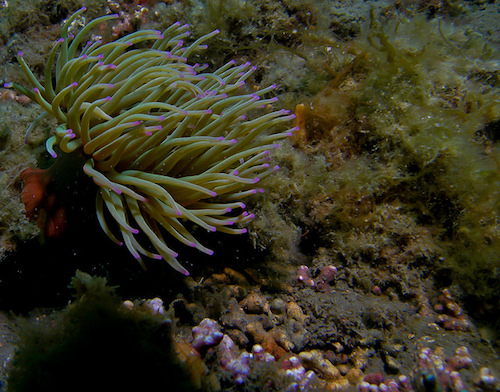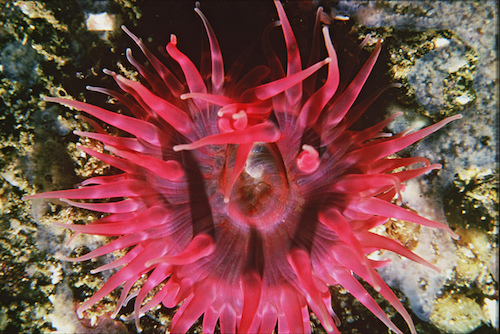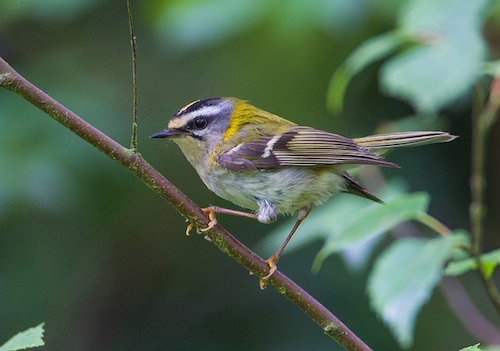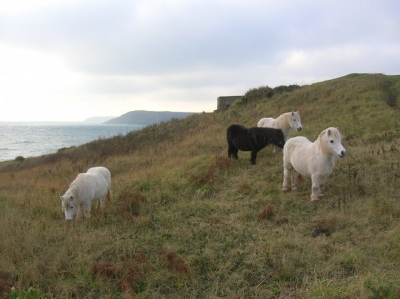The varied habitats at Kennack Sands – rockpools and marine communities, sand dunes, streams, scrub, with woodland and the heathlands of Goonhilly beyond – mean there is a wealth of wildlife to be found here, at any time of year. Enjoy exploring!
Western cliffs Keep an eye out for Rock Samphire. Even out of season, its yellowish-green, fleshy stems and leaves are very distinctive. It tends to grow in crevasses and cracks on the cliffs and rocks, sometimes in great profusion. It is edible, and tastes particularly good lightly steamed with fish.
Western beach and The Caerverracks You can find several species of seaweed in the intertidal zone (the part of the shore exposed between high and low tide), including Oarweed, Purple Laver, Tiny Redweed, and several species of Wrack – Bladder, Knotted, Channel and Spiral.
The rockpools close to Caerverracks provide different habitats, as they vary from shallow or deep and from sunny to shaded. You should find sea anenomes, including Dahlia, Beadlet and Snakelocks Anenome, as well as Blennies. Here and in the seaweed beds look for Spiny Starfish or Common Brittle Star. It is worth looking under rocks for crabs – Broad-clawed, Long-clawed Porcelain, Hairy or Hermit Crabs can all be found. If you are lucky, you might find the red Squat Lobster, but take care as it is aggressive when handled.
 |
 |
| Snakelocks Anenome | Dahlia Anenome |
Other marine life on the beach and rocks include Limpets, Periwinkles, Spotted and Unspotted Cowries, Topshells, Barnacles, Periwinkles and Common Mussels.
Natural England’s Charlotte Marshall enjoys rockpooling, and here index.php/article-archives/conservation/381-the-rocky-shores-of-kennack-sands she describes a visit to Kennack Sands.
The Towans The calcium carbonate sand – rich in the fragmented shells of tiny sea creatures – attracts thousands of snails in the warmer months. Here you will find Marram Grass, Sea Bindweed and Carline Thistle. Devil’s-bit Scabious, Meadow Clary and Stinking Iris also thrive here.
{gallery}Kennack flora{/gallery}
Further back on the dunes and along the footpath, keep an eye out for Butcher’s Broom. Its green, spiky leaves are not really leaves at all. They are in fact flattened stems, and butchers used to gather them to use as brooms to sweep their floors and keep work surfaces clean. In autumn and through winter, Butcher’s Broom produces large, bright red berries.
Stream bridge, and eastern beach The Gwendreath stream that flows under the bridge at the back of the beach is fringed with damp-loving plants such as reeds, Yellow Flag-Iris, Purple-loosestrife and Hemlock Water-dropwort. In spring and into summer, you can look for tadpoles and frogs, while dragonflies and damselflies buzz around you. The wet marshy area behind the sea wall on the eastern beach has similar wildlife, and in drier areas you can find Sea Radish, Sea Orache and Sea Beet.
 Firecrest
Firecrest
The woods behind the dunes were once dominated by Elm before Dutch Elm disease arrived. They are now full of Alder, Hazel and Sycamore. In the spring, you may find Bluebells, Wood Sorrel and orchids, and ferns beneath the shade of the trees. You can find many woodland birds here, sometimes including rarer visitors such as Goldcrests and Firecrests.
Quarry viewpoint Climb through sweet-smelling gorse and swathes of the rare Cornish Heath (which only grows on the serpentine soils) – both are at their best in July and August – to enjoy a panoramic view. A little earlier in the year, in May, the air will be sweet with Blackthorn blossoms.
Out to sea, you might spot Dolphins and Porpoises, and in the summer maybe the plankton-eating Basking Shark. The second largest fish in the world, it can often be glimpsed close inshore.
Conserving the habitats of Kennack Sands
Once upon a time, cattle would have grazed the dunes, joined by thousands of rabbits, keeping the scrub down and allowing more delicate plants to flourish. Cattle no longer graze at Kennack, and myxomatosis reduced rabbit populations, so the team caring for Kennack Sands have to use other methods, including cutting and burning scrub, as well as grazing ponies. The wonderful flora you can see now on the Towans is the result of some diligent planning and hard work over the last ten years in order to restore the fragile dune habitat index.php/article-archives/conservation/290-kennack-towans-restoration-of-a-dune .
 Grazing Ponies
Grazing Ponies
Further information
Find out about some of the flora, birds, butterflies and moths, and other animals you can see on The Lizard.
